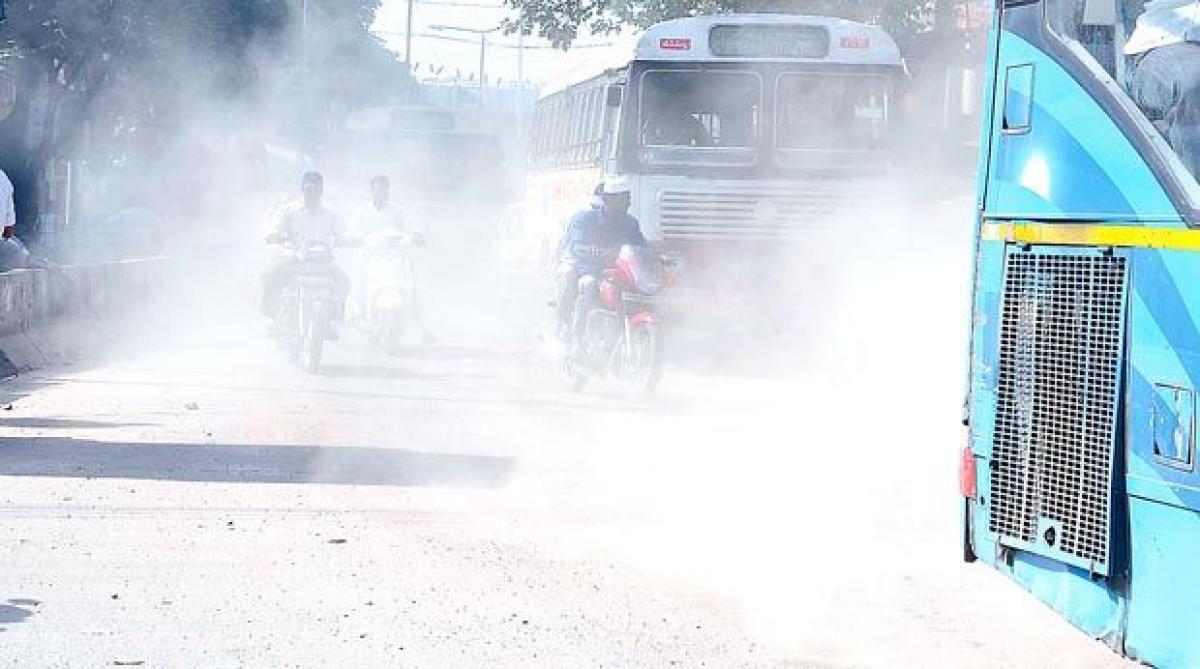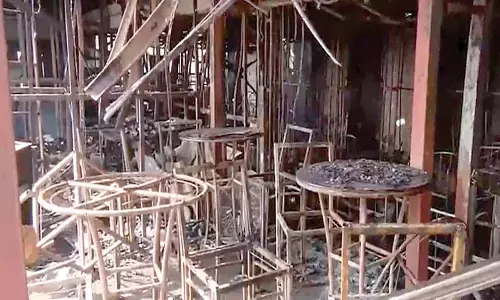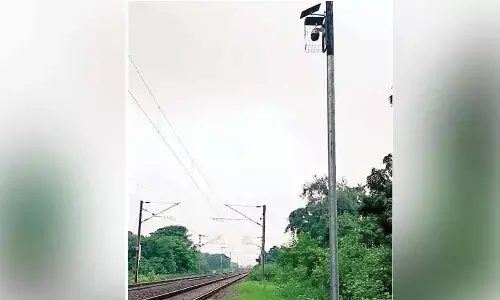Pollution in Hyderabad affects the cost of living

Amid growing concerns over deteriorating air quality in India’s major cities, recently the government launched the National Air Quality Index (AQI) that will put out real time data about the level of pollutants in the air and inform people about the possible impacts on health.

Amid growing concerns over deteriorating air quality in India’s major cities, recently the government launched the National Air Quality Index (AQI) that will put out real time data about the level of pollutants in the air and inform people about the possible impacts on health.
The new index covered 10 cities — Delhi, Agra, Kanpur, Lucknow, Varanasi, Faridabad, Ahmedabad, Chennai, Bengaluru and Hyderabad — each of which would have monitoring stations with AQI display boards with colour –coded with six levels – Dark green, the first level indicates good air quality, while maroon at the other end indicates severe pollution.
The aim was to eventually deploy the index in all cities with a population of over one million and identifies associated health impacts. In a study conducted by World Health Organization found that poor air quality reduces the lifespan of the average citizen by 3.2 years.
According to AQI data, Hyderabad is one of the worst air qualities, PM2.5 with high of 38 and PM10 level is 87 is also high in Hyderabad with the scale of maroon. PM 2.5 levels are commonly used as the best indicator of severe air pollution, while PM 10 particles are also a cause of public health concern, but less lethal. But when the scale touches maroon, the advisory reads: “May cause respiratory impact even on healthy people, and serious health impacts on people with lung/heart disease. The health impacts may be experienced even during light physical activity.”
The latest data of Air Pollution in Hyderabad reveals that, the city is highest with 76.92 levels and drinking water pollution and inaccessibility with 58.90 – Moderate level, dissatisfaction with garbage disposal as 75.88 high levels, dirty and untidy with 69.07 high levels. Noise and light pollution with 52.68 moderate levels, water pollution with 65.79 high levels, dissatisfaction to spend time in the city with 70.56 high levels and dissatisfaction with Green parks in the city 53.88 moderate levels.
Pollution in Hyderabad
| Air Pollution | 76.92 | High |
| Drinking Water Pollution and Inaccessibility | 58.90 | Moderate |
| Dissatisfaction with Garbage Disposal | 75.88 | High |
| Dirty and Untidy | 69.07 | High |
| Noise and Light Pollution | 52.68 | Moderate |
| Water Pollution | 65.79 | High |
| Dissatisfaction to Spend Time in the City | 70.56 | High |
| Dissatisfaction with Green and Parks in the City | 53.88 | Moderate |
Purity and Cleanliness in Hyderabad
| Air quality | 23.08 | Low |
| Drinking Water Quality and Accessibility | 41.10 | Moderate |
| Garbage Disposal Satisfaction | 24.12 | Low |
| Clean and Tidy | 30.93 | Low |
| Quiet and No Problem with Night Lights | 47.32 | Moderate |
| Water Quality | 34.21 | Low |
| Comfortable to Spend Time in the City | 29.44 | Low |
| Quality of Green and Parks | 46.12 | Moderate |
Air pollution and water pollution are growing health hazard in the city. Among the many sources of pollution, the transport sector is contributing a significant amount, with a direct correlation to increasing particulate matter pollution. It also found that:
(a) Ambient PM10 levels have increased over the last 5 years due to mixed growth in the city;
(b) Vehicular activity contributes significantly (from direct vehicular exhaust and indirect fugitive dust) to increasing PM concentrations;
(c) Of the vehicular contribution, contribution of diesel is also increasing concern (in the form of BC and sulfates);
(d) Long range transport of effluent gases and particles from industries around the city also increased during the sampling periods; and
(e) Waste burning in the residential areas, at landfills, and along the roadside is a notable source for fine PM.
Moreover, lack of regard for environmental laws by pharmaceutical companies in Telangana, the Central Pollution Control Board (CPCB) has recently issued notices to about 59 firms which top pharmaceutical pollution in Telangana, for not installing advanced online continuous effluent monitoring systems.
The main purpose of CETPs is to recycle and clean the harmful effluents generated from the pharma and bulk drug manufacturing industries in the state and release the treated water into the main rivulets.
As there are lots of complaints against the pharma companies for not adhering to the pollution norms, the Central Pollution Control Board has has asked them to install continuous monitoring systems to ensure accountability and transparency.
The directions were issued to companies that come under 17 categories of highly polluting industries, of which pharmaceutical industry is one. There are 143 pharmaceutical companies from across the country in the list, of which the maximum, 59, are from Telangana — 45 of these are located around Hyderabad in Medak district, mostly in Patancheru and Jinnaram mandals, IDA Nacharam in Ranga Reddy district, Kunoor Leather Park in Nalgonda, Enumamula CETP at Warangal and to the effluent treatment plants at Patancheru and Jeedimetla.
The biggest defaulters from Telangana after pharma companies are the cement plants — 12 of them did not respond to CPCB’s directives — followed by seven sugar mills, six tanneries and one each in iron and steel company.
The CPCB has been issuing orders to the state PCBs and to the companies regarding continuous online monitoring of pollution. Earlier, the CPCB had setMarch 31 as the last date for installing the monitoring devices, which was later extended toJune 30, but most of the companies not responded.
Broadly it can be surmised that a cocktail of poisons in air, water and land has adversely affected the health of the people of Hyderabad.
Recently a team of doctors from Occupational Health and Safety Centre (OHSC) and Lokmanya Tilak Medical College (LTM), undertook a study on certain people on a random sampling basis, for medical verification of certain diseases in certain localities of Hyderabad and Sanga Reddy.
Environmentally induced respiratory disorders are known to be present in polluted areas. Using spirometry1 to determine respiratory illnesses, doctors confirmed that the incidence of respiratory disorders is greater in the study group at a statistically significant rate. 28 of the 38 individuals tested in the study group were found to be affected whereas only 12 out of the 34 tested in the control population were affected. The occurrence of asthma and bronchitis is 4 times higher in the study group. The relative occurrence of respiratory disorders in the study population was double the incidence in the control population.
Doctors also verified medical records to ascertain the incidence of cancer. Analysis of the records established the occurrence of cancer in the study group to be 11 times higher than in the control group, which is statistically highly significant. Incidence of heart disease in the study group was found to be at least 16 times more than that of the control group.
As per medical experts, the pollution causes damages to key systems found to be affected are:
· Nervous system 1 in every 10 are affected
· Circulatory System 1 in 20 are affected
· Respiratory System – every 1 in 20 are affected.
· Digestive System 1 in 10 are affected
· Blood and Blood forming organs –1 in 29 people are affected. Endocrine, nutritional and metabolic systems 1 in 35 persons are affected.
· Neoplasms – Skin and Subcutaneous tissues – Congenital malformations, deformations and chromosomal abnormalities observed one in 10.
The implications of these findings are serious. The study demonstrates that the health of the residents was being significantly affected by the current levels of industrial activity. It is incumbent upon the state regulatory authorities responsible for public health to investigate this matter, to further define the scope and severity of the problem, and to initiate processes which will return the community to the state of health enjoyed by them prior to this era of reckless industrialisation.
It is evident that the people living around these industrial estates have not received justice even after all these years. Their fundamental right to clean air and water continue to be robbed by greedy criminal corporations.
G.Rajendra Kumar
Next Story

















